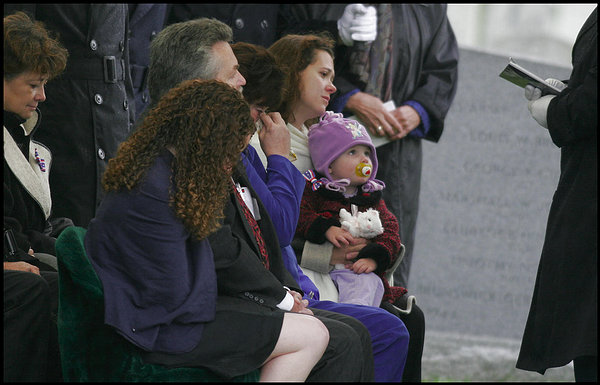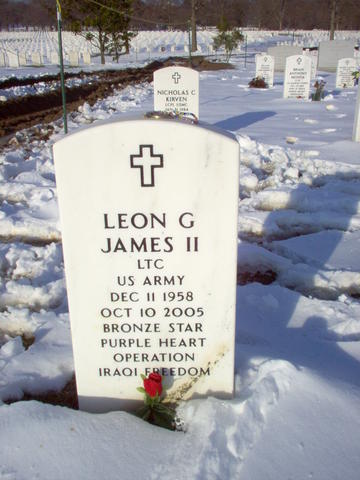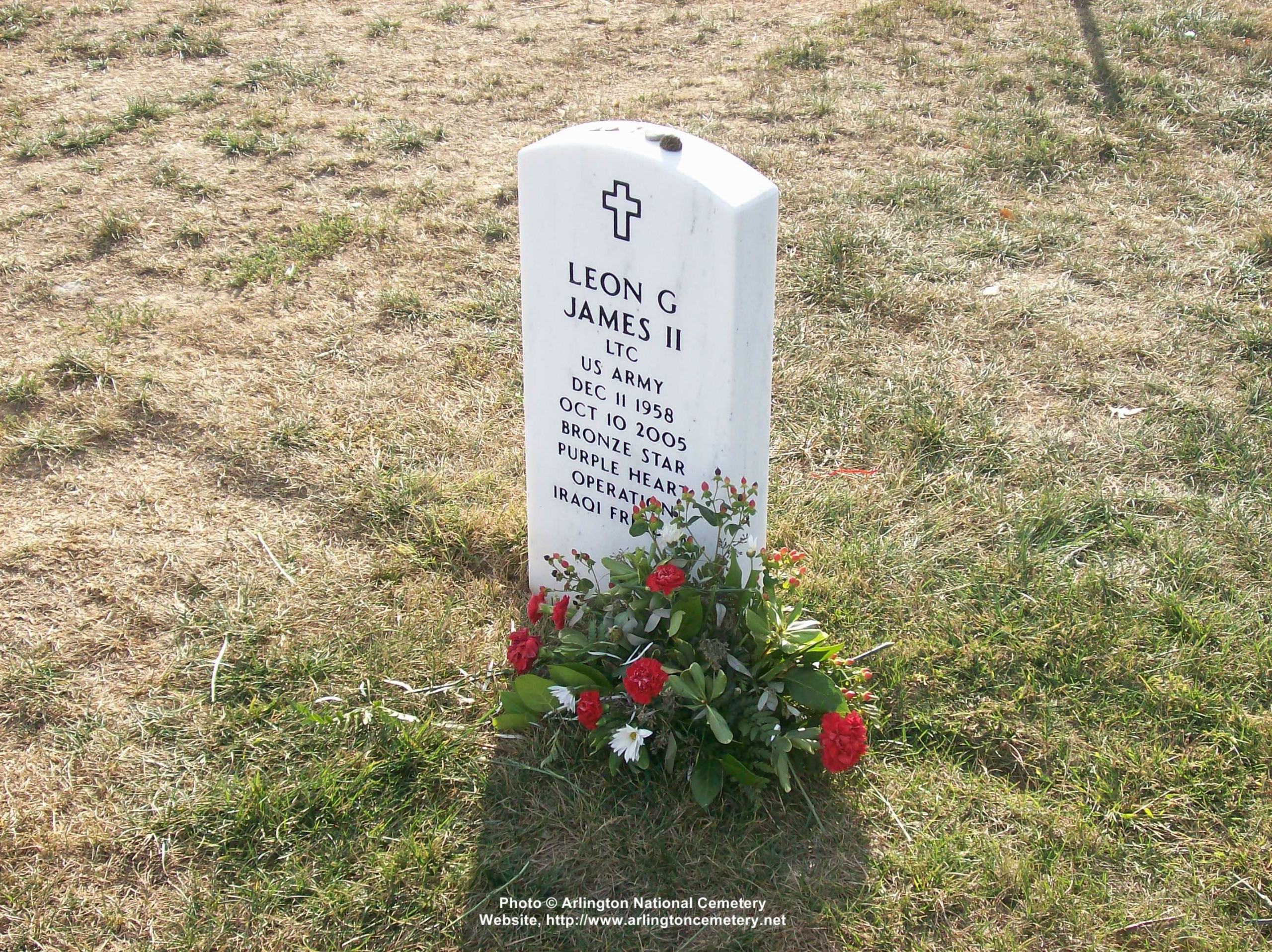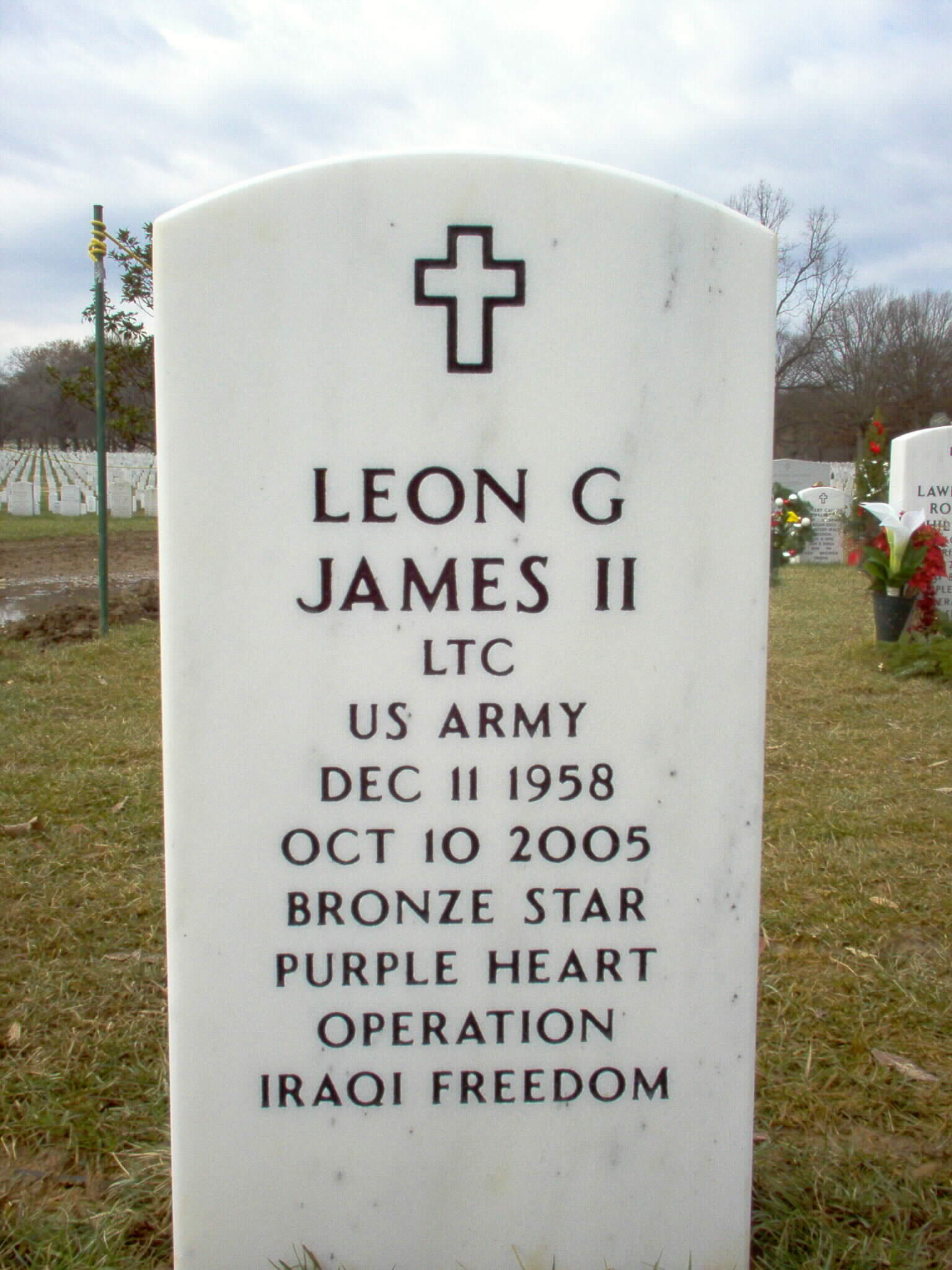NEWS RELEASE from the United States Department of Defense
No. 1035-05
IMMEDIATE RELEASE
October 11, 2005
Media Contact: Army Public Affairs – (703) 692-2000 Public/Industry Contact: (703)428-0711
DoD Identifies Army Casualty
The Department of Defense announced today the death of a soldier who was supporting Operation Iraqi Freedom.
Lieutenant Colonel Leon G. James II, 46, of Sackets Harbor, New York, died at Walter Reed Army Medical Center in Washington, D.C., on October 10, 2005, of injuries sustained in Baghdad, Iraq, on September 26, 2005, when an improvised explosive device detonated near his HMMWV during combat operations. James was assigned to the 3rd Battalion, 314th Field Artillery Regiment, 2nd Brigade, 78th Division, Fort Drum, New York.
A Fort Drum officer who passed up retirement to continue serving in the Army died Monday of injuries he suffered in an explosion in Iraq, his family said.
The Defense Department said Tuesday that Lieutenant Colonel Leon James II, 46, of Sackets Harbor, died at Walter Reed Army Medical Center in Washington, D.C. He was injured in a road attack in Baghdad September 26, 2005, that claimed the lives of two other soldiers, Sergeant First Class Casey Howe of Philadelphia, New York, and Master Sergeant Tulsa Tuliau of Watertown.
They were assigned to Fort Drum’s 3rd Battalion, 314th Field Artillery Regiment, 2nd Brigade, 78th Division.
James’ mother-in-law, Ursula Hicks of Fayetteville, North Carolina, said the men were riding in a Humvee when they swerved to avoid a suspicious vehicle, which then exploded.
Hicks recalled how her son-in-law loved spending time outdoors.
“He was talking about retiring when he got back to go hunting and fishing with my husband,” she said.
He leaves behind his wife, Sylvia, and three daughters: Maria, 16, Rachael, 11, and Kathryn, 5. James met his wife while stationed at Fort Campbell, Kentucky. Hicks said he declined to retire five years ago.
The family lived in Sackets Harbor, along Lake Ontario 19 miles west of the base, and James was an elder at United Presbyterian Church.
“When he left here he told us he would come back, and he did come back,” Hicks said. “He came back so we could make closure and for the girls to see him one more time.”
Memorial held for fallen soldier
16 October 2005Family and friends gathered at the Sackets Harbor Central School Saturday morning to pay their respects to a fallen soldier.
Lieutenant Colonel Leon G. James II, died on October 10, 2005, from injuries he suffered when a roadside bomb exploded near his vehicle in Baghdad, Iraq.
That bomb also claimed the lives of two other soldiers, Sergeant First Class Casey Howe and Master Sergeant Tulsa Tuliau.
James and his family lived in Sackets Harbor for seven years, where he was an elder at the United Presbyterian Church.
His burial will take place at Arlington National Cemetery.
Iraq victim Springfield native
Tuesday, October 18, 2005In his e-mails to his mother, Army Lieutenant Colonel Leon G. James II reminded her to keep safe.
But it was James, a Springfield native deployed six months ago to Iraq, who was in harm’s way.
James, a married father of three, died October 10, 2005, after being wounded in a bomb blast on an Iraqi roadway. He was 46.
“We always thought this wouldn’t come to us,” said Emma Jean James, the soldier’s mother, who lives in Longmeadow. “But it has.”
Emma Jean James was writing an obituary and arranging for a gathering yesterday to be held at her home this weekend to honor the son many knew as Buster.
Leon James will be buried at Arlington National Cemetery October 25, 2005.
James was the 10th soldier with Western Massachusetts ties who died as a result of the U.S. war in Iraq.
He was a member of the 3rd Battalion, 314th Field Artillery Regiment of the 2nd Brigade 78th Division at Fort Drum in New York where he lived.
“Lots of people say they (the Army) owe me a (national burial),” said Emma Jean James. “I just feel honored.”
Colonel James grew up with two brothers and three sisters in Springfield. His mother said he and his siblings were jokingly referred to as the James Gang.
3 Servicemen, 3 Stories of Dedication
Burials at Arlington Honor Those Who Fought in Iraq
By Lila de Tantillo
Courtesy of the Washington Post
Wednesday, October 26, 2005
Three men who chose to risk their lives for their country by serving in Iraq were laid to rest yesterday at Arlington National Cemetery. One had switched military branches to pursue his dream of flying helicopters; another could have retired but chose to remain in the service; and a third decided to reenlist on the condition that he be sent to Iraq.
Chief Warrant Officer Dennis Patrick Hay of Valdosta, Georgia, was killed August 29, 2005, when the helicopter he was piloting was attacked by enemy fire in Tal Afar, Iraq, near the Syrian border. Hay, 32, was assigned to the 4th Squadron, 3rd Armored Cavalry Regiment, of Fort Carson, Colorado.

A horse-drawn caisson led a procession through rain and blustery wind yesterday from the U.S. Coast Guard Memorial to Hay’s final resting place. A military band played “America the Beautiful” as an honor guard folded the flag covering the urn that held Hay’s ashes. Major General Charles Wilson presented the flag to Hay’s wife, Rebecca. Hay also was mourned by his children, Jacob and Abigail, parents Barry and Patty, brother Barry and sister Bridgette.
“The most important thing to Dennis was that he wanted people to know that he had a relationship with God, and he wanted to make sure that other people did, too,” said Misty Ricks, 30, a friend from Brunswick, Georgia, who had known Hay for more than a decade from Agape Christian Fellowship in St. Marys, Georgia.
Ricks knew Hay as an adventurous guy in her youth group who rode a BMX bike and liked to use it to do stunts — but only if he could execute the thrill-seeking maneuvers safely.
Hay had served as a parajumper in the Air Force before applying for a transfer several years ago to the Army so he could train to become a helicopter pilot. He hoped to use the skill one day as a missionary to bring aid to those in need.
“Dennis went back for a second tour because of the Iraqi children,” Ricks said, adding that he had told her that if others could see the difference the United States was making in the young Iraqis’ future, “they would understand why he was going back.”
Lieutenant Colonel Leon Gifford James II of Sackets Harbor, New York, was wounded September 26, 2005, in Baghdad when an explosive device detonated near his Humvee. He died October 10, 2005, at Walter Reed Army Medical Center. James, 46, was assigned to the 3rd Battalion, 314th Field Artillery Regiment, 2nd Brigade, 78th Division, based at Fort Drum, New York.
Friends said that James, who served as an elder at United Presbyterian Church in Sackets Harbor and helped manage its finances, had been eligible to retire from the service. But he decided to stay to fight for a cause he believed in. He kept in excellent shape — even outrunning men two decades his junior in training drills, his friends said.
For James’s full-honors funeral, a team of dark horses led the procession from the Old Post Chapel. A military band played “Amazing Grace” as the flag-draped coffin — covered with a clear plastic sheath to protect it from the rain — was brought to the grave site. Major General Wayne Erck presented the flag to James’s wife, Silvia, who was accompanied by their children, Maria, Rachael and Kathryn.
Marine Sergeant Mark P. Adams of Morrisville, North Carolina, was killed October 15, 2005, by an improvised explosive device while conducting combat operations in Saqlawiyah, Iraq. Adams, 24, was a reservist attached to the 2nd Marine Division, 2nd Marine Expeditionary Force (Forward).
A Marine honor guard from the barracks at Eighth and I streets NW in Washington carried Adams’s gray coffin to a grave site near a memorial to those who died serving in Somalia. Navy chaplain Robert Rearick delivered a sermon before the guard presented a folded U.S. flag to Gunnery Sergeant Barry L. Baker, who knelt before Adams’s father, Phillip Adams, to hand him the tribute.
Mark Adams was the youngest of three sons, all of whom served in the military. As a freshman, he joined the wrestling team at Cary High School in North Carolina, and by all accounts his performance at first was terrible. But over several years, he worked to strengthen his body and refine his technique. By his senior year, he was chosen as captain, and the team won a state championship.
Adams joined the Marines shortly after graduation but saw little action during several years stationed in the Pacific. He returned to his home town near Raleigh, where he volunteered as a coach for the wrestling team, but soon decided to return to the service.
Jean Tursam, 57, a longtime family friend, said the elder Adams told the 600 people who attended a memorial service at Colonial Baptist Church in Cary about his son’s motivation.
” ‘We’re going to choose to fight them in Iraq or we’re going to choose to fight them here,’ ” Mark Adams had said.
Tursam said that even after the young Marine was promoted to platoon leader, he still chose to take the dangerous position in the turret of the Humvee, where he was killed by a piece of shrapnel. “He wouldn’t ask his men to do something he wouldn’t do himself,” she said.
Hay, James and Adams were the 181st, 182nd and 183rd service members killed in the Iraq conflict to be buried at the cemetery.


Michael Robert Patterson was born in Arlington and is the son of a former officer of the US Army. So it was no wonder that sooner or later his interests drew him to American history and especially to American military history. Many of his articles can be found on renowned portals like the New York Times, Washingtonpost or Wikipedia.
Reviewed by: Michael Howard

